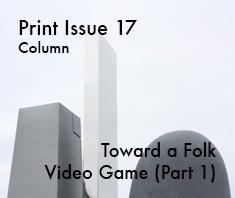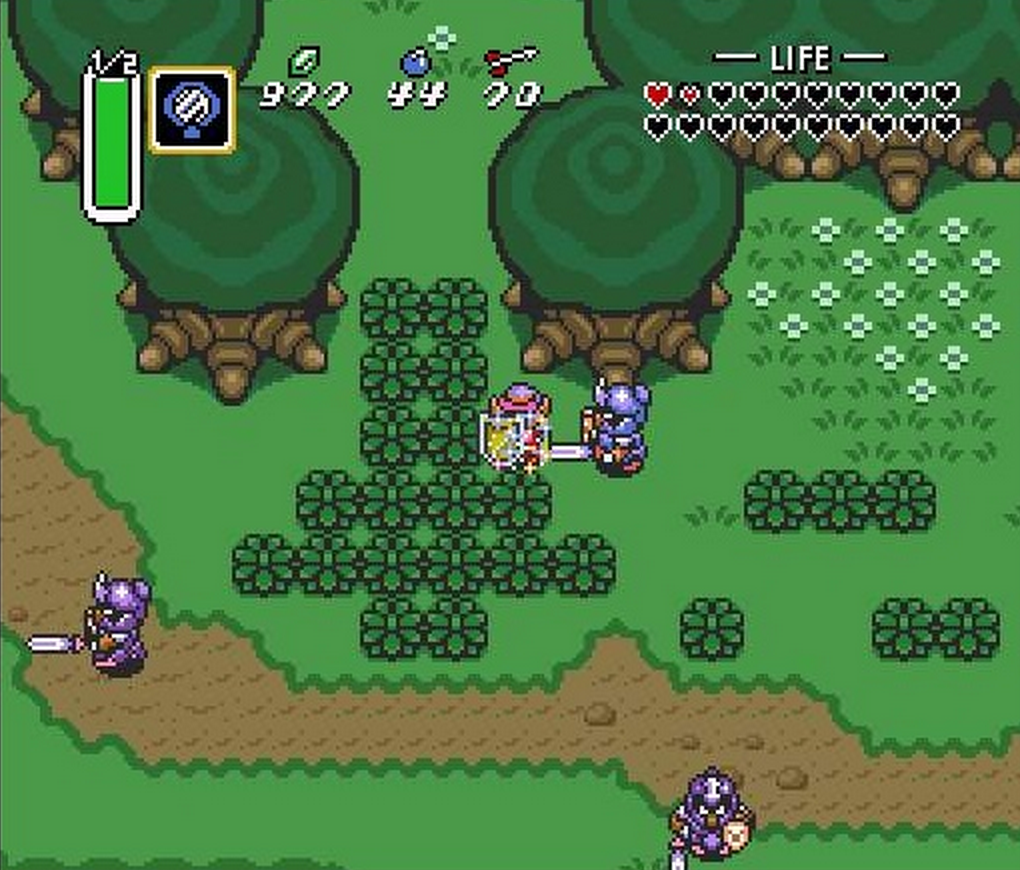Toward a Folk Video Game (Part 1)
By Nicholas O’Brien
This column has been pulled from SFAQ print issue 17.
In his germinal essay, Without a Goal, Jesper Juul discusses how contemporary games are reshaping the core definitions and characteristics of a video game. His argument challenges the prerequisite that games require a reward system based on a set goal. By looking at games like The Sims and open world titles like Grand Theft Auto: San Andreas, Juul contests that the goals are quickly becoming secondary or ancillary mechanics within contemporary titles and that the value of games like The Sims comes from an emergent form of expressive play. This style of play is not based in collecting points but rather based on creating meaning based on personal agendas and individual play style. Designing a game that is open enough to allow players to engage with their content and mechanics freed from prescription has been the defining difference between games now and goal-based arcade predecessors.
The expressivity that Juul identifies not only affords different styles of gameplay, but also accommodates a new approach to thinking about games as a cultural platform for creative expression. Although not explicitly discussed within Juuls argument—or built upon since then—this new tradition (or expectation) for expressivity has also lent itself to the emergence of a new path for the development of video games. This path is what I will call a folk video game. This yet-to-be-realized genre (or subgenre) borrows from historical precedents that have up to now shaped gaming history. But the important departure for the folk video game occurs when the content and mechanic of its gameplay extends outside of the history of the medium and attempts to speak to a larger tradition of play, collage, and storytelling, within and outside of the video game.
Tracing some of the sources that inspire a folk video game requires looking back a bit further than the more immediate history of the arcade console. A starting point can be Johan Huizinga’s analysis of play and games as a central and distinguishing role within human civilization. In his treatise, Homo Ludens, Huizinga outlines the importance of play for creating lasting meaning within a social environment. This meaning and significance can translate to spiritual ritual practice or toward establishing local/tribal cultural traditions. In these traditions the nuances and uniqueness of ritual practice and gameplay within a community creates cultural difference amongst tribes and communities. The differences within these traditions, over time, can be considered the basis of a community establishing its unique folklore.
A folk video game is not only influenced by Huizinga’s analysis of play and gaming, but it is also looking at a long-standing interactive relationship between humans and machines. Norbert Wiener’s theory of cybernetics becomes instructive in building upon the folk tradition that play creates. Wiener speculates that within any given system the input often does not equal the output, and that in order to increase the output of a given machine, more input must be fed into its process. This loop of input/output is called feedback, which one can use to calculate the efficiency of a machine. Wiener speculated, however, that if enough “noise” is reduced in this process of feedback, that a machine could potentially reach maximum efficiency.
Although initially applied to electrical and mechanical engineering, this theory quickly found roots in the humanities and other social sciences. Play and games become a fascinating machine wherein the output has the potential for exceeding maximum efficiency. This process is the basis of developing a folk video games tradition. Within the social system of expressive games, play (as an input) can equate to something larger than the system in which it exists (the output). In other words, when a game’s output becomes greater than its input, it veers on becoming a folk tradition.
This mechanism is sometimes hard to identify, since the theoretical basis of its existence is typically based in engineering or electrical systems. But when this mechanic is applied to a social system, the variables of output become a bit more expansive. The input of a social system could have a variety of outputs, and the strength of that system is not exclusively measured on expected outcomes. If a social system like a game environment has the opportunities to generate a variety of outputs (those expected and not), then the game (as a system) is engineered with the intentions of generating a folk videogame tradition.
An example of this expansive social system could be found in something like an MMO or Massive Multiplayer Online Game. When Eve Online developers CCP decided to create a physical memorial in Iceland for a battle that took place in the virtual space of New Eden, the social mechanism of the game generated a folk outcome. The output of this sculptural commemoration exceeds the input of player destruction. The only problem with this example is that the output of the statue is not directly created from players. CCP generated this outcome as a response to the social system they developed, but their response is not wholly generated within the social system of the game.
This being said, the movement toward a folk video game is not an inherently new process. Although contemporary games more frequently offer expressive play for players, expressive play manifested as a design principle (or motivation) for many early text-based adventures. Most notably is William Crowther’s Colossal Cave Adventure (1976), which was developed with the intention of sharing his love of spelunking with his daughters. Though it is often lauded as a landmark game for being one of the first to be shared over network technology (time-sharing networks based out of university labs), the expressive development of this game is another important link in establishing the variety of influences shaping the development of a folk video game. When the intention of the game has expressive goals—separate or secondary to the goals of the actual game itself—then the title creates significance and/ or meaning beyond its gameplay.
These precursors for the development of a folk game tradition can also borrow from non- video-based gaming traditions. By looking at Live-Action-Roleplaying (LARPing) and pen and paper games such as Dungeons and Dragons, the developer of a folk video game must consider how these gaming environments are designed to create a space of shared or mutual empathy. As Shoshana Kessock articulated in her presentation at the Different Games Conference in April of this year, LARPing communities’ primary mode of creating a game (or LARP) is based on the creation of systems of empathy and communal affinity. This system of agreement is not solely beneficial for the purposes of creating a collective suspension of disbelieve—it is instead a way of creating a scenario in which all players’ imagination, fantasy, experience, and participation are equally valued. Thus all forms of expression and all different types of players are equally encouraged and supported within the community of players.
Favoring a diversity of expressive types of gameplay within a LARP should similarly manifest within a folk video game. As with a LARP, a folk video game can embrace and encourage the creation of affinity networks and decentralized—yet shared—empathy. As opposed to creating a competitive environment—another false prerequisite for games that Juul dispels—the folk video game can be crafted to create collectivity and comradery. The diversity of expressivity from the player’s perspective combined with expressive development intentions can potentially create an experience where the input from players can reach beyond maximum output. The feedback between the expressivity of the developer and the player can amplify to a point where noise (a problem typically generated by poor design) is not only minimized, but that the machine begins to generate experiences it either never anticipated, or else never intended (as is the case with the Eve Online monument).
A folk video game that can accomplish the combination of these different histories and traditions could contribute a significant and radical platform for experiencing and discussing contemporary media. As it currently stands, few titles come even close to approaching this threshold for the medium. Instead, the insularity of video games as a genre has—regardless of growing popularity—entrenched itself within a rather bleak and hostile conversation that rarely stems beyond its own discipline.
This is not to say that all is lost. To lump all video game communities within mass-market blockbusters (which is what often gets assumed or touted when video games as a genre are discussed) would do a disservice to the diversity of communities that exist within gaming subcultures. That being said, these communities are often pushed to the margins and as a result rarely get opportunities to make significant contributions to games as a genre. Because of that marginalization, the focus of smaller production houses and more independently minded individuals within gaming subcultures should look toward the prospect of a folk tradition. As stated before, the development of a folk video game can be an opportunity to break or disrupt the discipline. In doing so, a folk video game would still mechanically operate within the limitations of the discipline while still garnering interest, praise, and critical attention beyond its immature big-budget peers.
Great video games already spark a multitude of products and forms of expression in other media. Often, games considered groundbreaking within their genre have had multiple translations to other formats: television shows, comics, toys, feature-length films, sculpture, illustration, murals, graffiti, etc. However, these offshoots rarely create meaningful expressions within their respective media, and—perhaps most importantly—are typically only generated for increasing revenue for a developer or publisher. The very definition of video game ephemera emphasizes the fact that they are made and distributed for profit’s sake. Thus even a great game like A Link to the Past, no matter how much ephemera it might generate, cannot be classified as a folk video game.
Instead, what draws The Legend of Zelda: A Link to the Past (1991) closer to being a folk video game is the way that its expressivity and feedback have generated critical and meaningful content beyond its discipline. This argument becomes harder to make the close you examine the contributions that A Link to the Past has made outside of the video game industry. Though pioneering the output of its gameplay does not exceed its input, and in turn does not create a mechanism or system of sustained (and perpetual) expressivity. Expressivity in A Link to the Past is extremely limited and feedback is often one-dimensional: through collecting items, you defeat enemies, gain crystal shards, rescue maidens, and eventually—spoiler—secure the Tri-force.
Thus the creation of a folk video game must have expressivity imbued within it from the onset of its development. With Crowther’s Colossal Cave Adventure the expressivity of sharing a real world activity with others creates a meaningful bond between author and player before the game even begins. With the knowledge of the intentions of the game, a system of empathy is established which allows for a system of play that has the potential for expressing something meaningful beyond video games as a medium. This is not to say that Colossal Cave Adventure is a folk video game, but it is important to distinguish the difference of intentions between it and A Link to the Past in order to examine the ways in which expressivity within a game can expand beyond the technical or mechanical boundaries of its discipline.
However, making this comparison between Crowther’s early effort and Nintendo’s smash hit does not give a clear indication of the current status of the establishment of folk video games tradition. As stated before, small productions and independent video games titles are more immediately approaching the threshold of folk tradition. However, the feedback found within widely celebrated indie games like Braid or Super Meat Boy do not provide meaningful expressive outlets beyond video games as a discipline. Other so-called indie games like Flower begin to broach subject material that addresses environmentalism, ecology, and biodiversity. But the contributions this game makes to those disciplines does not necessarily enhance the already existing discourse.
The examination, albeit cursory, of the mentioned indie games presents an interesting paradox within that community. Although these titles are expanding and introducing new narratives, character, mechanics, and forms of expression, they are doing so only to the extent that they are comments on video games as a medium. With that in mind, one might consider how the folk video game might ask these same questions, or present any challenges to the video game medium, but instead uses the medium as a way to employ play and expression as a means to an alternative end.
Games such as Oil God come to mind, wherein the goals of the game are not challenging the format of video game play, but the content of the game poses challenging and meaningful contributions to the criticality of manipulating oil markets in global economics. Another game that similarly presents complex subject material without challenging gaming conventions is Dys4ia. In this Flash game the developer Auntie Pixelante (Anna Anthropy) employs a minigame mechanic (similar to Warioware) as a way of expressing the emotional complexity of transitioning genders. Though the tone of Dys4ia is often humorous, the intensity of the empathy that is created through play creates powerful meaning that transcends the medium. However, as arresting as this game is, the lack of expressive gameplay is not present (though the input and output feedback within Dys4ia arguably goes past maximum efficiency).
Thus the problem of establishing a folk video game tradition still poses a vexing challenge for developers and enthusiasts of this medium. I suspect that part of this problem comes from the physical limitations of being grounded to an electronic appliance. Expressivity within LARPing environments is so satisfying and rewarding because the feedback that is input into this system of empathy has physical manifestations that create meaning for players outside of the gaming scenario (as pleasantly suggested by the profile of Kenyon Wells in the documentary Darkon). The “liberation” that occurs within this game to reach beyond the limitations of the game as a discipline has meaningful results for players.
However, because of the technical limitation of the video game, one has to abide by the log- ic of a computer in order to generate output and feedback. Thus the noise of a computer becomes a hindrance toward creating a folk tradition within video games. Remote examples of video games verging into folk territory only occur within expressive gameplay that unintentionally renders a gameplay or mechanic useless or irrelevant. In this way, the logic of the game must be broken in order for a folk video game to emerge. But maybe this isn’t necessarily a bad thing, and maybe the rupturing of a video game’s logic (or computational processing) allows for an expressivity to emerge. An example of this kind of folk-like expressivity and feedback begins to take shape in intentionally broken games like Goat Simulator. Although the commentary and meaningful expressivity of this game is mostly limited to video games as a genre, the emergence of the community of support and enthusiasm around this game (as a joke) begins to inform a kind of outside-the-game expressivity.
The problem is that the folk tradition expressed within Goat Simulator is not one that sustains its significance for very long—its bite has already worn off. The expressivity of the development and play of this game does not add up to establishing a folk video game tradition. To that end, one must consider the ways in which the real world, non-insular community efforts of the people that came together to make Goat Simulator a reality should be viewed as an important precursor for an emergent folk tradition within video games.
Previous contribution by Nicholas O’Brien include:
Gaming Development as a Model for Contemporary Art Production









